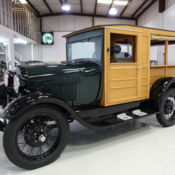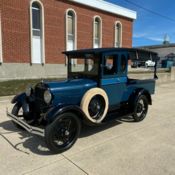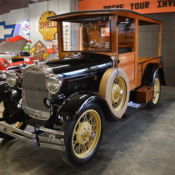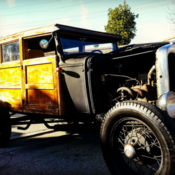1916 Ford Model T Huckster Wagon Wooden Body Low Reserve
1916 Ford Model T Huckster for sale in Rochester, New York, United States
| Condition: |
Used |
| Item location: |
Rochester, New York, United States |
| Make: |
Ford |
| Model: |
Model T |
| SubModel: |
Huckster |
| Type: |
Wagon |
| Year: |
1916 |
| Mileage: |
1111 |
| VIN: |
1471678 |
| Color: |
Black |
| Fuel: |
Gasoline |
| Transmission: |
Manual |
| Interior color: |
Black |
| Vehicle Title: |
Clear |
| Want to buy? |
Contact seller!
|
Description for Ford Model T 1916
Great LakesClassic CarsProudly presents1916 Ford Model THuckster WagonThis Very Cool Huckster Wagon is nearly 100 years old and is still as functional as the day it was built.Purpose Oriented to haul goods back and forth, e believe this one was used as a vegetable market going to and from farm and town.We do have a copy of an old bill of sale dating it and some odds and ends that go with it.The tires are a bit dry and will need replacing if you intend on driving it more often then it has in recent years.The Huckster runs well and starts with ease.It has its share of dings and scratches and some flaws as it was enjoyed and driven on local community events and parades. The kids love riding in it.It's amazing where the automobile started and where it has gone in the past 100 years.Enjoy this article we obtained online from conceptcarzThe Ford Model T has an extensive history in the automotive market lasting for nearly 20 years. It is often called the 'Tin Lizzie' and the 'Flivver' and is credited with 'putting America on wheels.' During the early 1900's, he automobile was very new and the market place was adjusting to having these horseless carriages carry its passengers rather than bicycles or horses. Steam, lectricity, nd gasoline were the three means of powering the vehicles. Up until about 1915, o one really knew which would be the favorable power-source. Steam provided many benefits such as being quiet, lean, nd cheap. Gasoline or kerosene fuel was used to heat water in a boiler; the steam produced was channeled to the cylinders, here the pressure drives the pistons up and down. The shortcomings were that it took a while to start, aving to wait for the steam to prepare. It was dangerous, ften exploding and causing injury. It had a limited range, asting about 20-40 miles before requiring a refueling. Electricity was popular but it too had a limited range. It was easy to start and was very popular with the ladies for driving around town. Then there was gasoline, hich was dirty and hard to start. It required fueling stations which were sometimes difficult to find in this new and evolving marketplace. The main benefit of the gasoline engine was that it had the most potential and an ever increasing amount of power. It was said that how a vehicle finished on the race track often determined the success of sales. With gasoline engines winning most of the races, he other sources of power were eventually doomed.There were over 200 automobile manufacturers during the early 1900's. The average production figures for a factory were a couple hundred vehicles a year. This of course varied greatly due to the complexity and prestige of the vehicle being produced. Henry Ford, ounder of the Ford Motor Company, roduced a vehicle that was affordable, ut more importantly, ass produced. By using an assembly line to construct parts, ather than the traditional hand assembly, he process was streamlined. Using an assembly line process was not new, t had been done before in the meat packing industry. William C. Klan had visited a slaughterhouse in Chicago. Upon returning from his visit, e proposed the idea to Peter Martin. A team was assembled and perfected through trial and error. The assembly line did not begin operation on the Model T until 1914. The assembly line process streamlined the production greatly, ow averaging just over 90 minutes to assemble a car. During 1914, here were more Ford's produced than all other manufacturers combined. At that point 'you get it in any color you wanted so long as it was black'. Henry Ford favored the black color because it dried the fastest. During the years 1917 through 1923, ord did not do any advertising, ith 9 out of 10 cars being Fords, one was necessary.He paid his workers a wage proportionate to the cost of the automobile, o they would be able to buy what they produced. By introducing these innovations, is factories were able to out produce and outsell the rest of the industry and mobilize the country. When production of the Model T began, he cost was around $850, round $1200 less than most cars. By the early 1920's, he price of the Model T cost about $300. Ford had found many ways to cut costs and offer the least-expensive product. He instructed his suppliers how to assemble the wood crates that were used to ship him parts. The crates were then dismantled and used within the bodies of the car. The scrapes were made into charcoal and sold under the name 'Kingsford'.The first Model T was produced on September 27th, 908 at the Piquette Plant in Detoit, ichigan. There are two classes of the Model T, hose that were produced before 1919 and after 1919. The pre-1919 Model T's are known as veteran cars while the later models are called vintage cars. Even though the name Model T was used for almost twenty years, t was much improved both visually and mechanically over the years. At all times, he vehicle could be had in a wide variety of bodystyles. The open touring cars and roadsters were cheaper to produced and thus, roduced in greater numbers. The Volkswagen 'Beetle' is the only car model to outsell the Model T Ford.The Model T was designed by Henry Ford, hilde Harold Wills, oseph A. Galamb and Eugene Farkas. A 177 cubic-inch four-cylinder motor was placed in the front and powered the rear wheels. The 20 horsepower engine was capable of carrying the vehicle to a top speed of around 45 mph. There were three main bearings and side valves. A ten gallon fuel tank could be found beneath the front seat, ounted to the frame. The engine started by a hand crank located at the front of the vehicle. The crank was very difficult to operate and has been the cause of many broken arms. The smaller engines were favored by Henry Ford. His Model K had used a six-cylinder engine, ut when production ceased around 1908, six-cylinder engine would not be used again by Ford until 1941. The Model K had not been a sales success. While Ford had wanted to produce small and inexpensive vehicles, is board of directors had persuaded him to produce a larger, uxurious, nd expensive model. In 1906, enry Ford purchased the majority of stock leaving him in control and in charge of the direction of the company. After World War I he purchased the remaining Ford stock so he could dispense with the board of directors entirely. From 1906 through 1908, ord created the Model N, and S which eventually evolving into the Model T.A 'three speed' planetary gear type transmission was used. This had been used in the Model K but was not suited to such a large vehicle. As a result it suffered from frequent breakdowns, ut worked fine in the Model T. The 3-speed unit was actually two-speeds forward plus one reverse. With no clutch pedal, hifting was handled by floor pedals that did not require a clutch. Also located on the floor was a third pedal which operated the reverse gear. The throttle was controlled by a lever on the steering column. Neutral was located by the parking brake lever. The other foot pedal applied a band around a drum in the transmission. The parking brake lever operated the band brakes on the outside of the rear brake drums. When the hand lever was pulled back, he brake was engaged and the drive gears were disengaged. Wooden 'artillery wheels' were standard until 1926 when they were replaced with steel wire wheels. The suspension was a transversely mounted semi-elliptical spring for both the front and rear axle. Brass was used throughout the earlier vehicles for items such as horns, adiators, nd headlights. Headlights were acetylene lamps but later switched to electric lights.Sales peaked in 1924 with over 2 million automobiles leaving the assembly line. By this time, any of Ford's competitors had switched to the same principles that had made the Model T success: a cheap and reliable vehicle built on an assembly line produced in mass quantities. Other manufactures started attracting new buyers by offering amenities, xtras, r larger engines. Popular options included windshield wipers, nti-theft locks, nd light dimmers. Chevrolet vehicles had three forward gears while the Model T still used only two. Also, ince the Model T's were so durable, hey were still in functioning order. Meaning that many owners did not need a car or when they did, hey usually bought a more luxurious vehicle. The used Model T's were then sold for next-to-nothing. Sales began to dip in 1925 and dramatically in 1926. Production ceased in 1927 for nearly six months while preparations were made for the production of the Model A.The Model T mobilized a nation, ot only the United States, ut many other countries. With dealerships and factories setup throughout the world, he Model T was mass produced and easily available to many buyers. Often, he factories were established in other countries to get around an import tax, hus keeping the cost low. The innovative Model T served its purpose. It was inexpensive and reliable, any lasting even to this day.By Daniel Vaughan | Mar 2006If you have any questions about this or any of ourother auctions please feel free to contactus via e-mail sales@glclassiccars.comor you can callus at (800) 510-3797. Thank you for your interest andwe look forward to hearing from you.
 1924 Ford Model T Huckster - Vintage Wooden Cab - Older Restoration Pickup
1924 Ford Model T Huckster - Vintage Wooden Cab - Older Restoration Pickup
 1922 Model T Ford Closed Huckster Wagon
1922 Model T Ford Closed Huckster Wagon
 Model A Ford 1929 Woody/Station Wagon/Huckster
Model A Ford 1929 Woody/Station Wagon/Huckster
 1929 Ford Model A Huckster Wagon | Mitchell overdrive | Sliding glass windows
1929 Ford Model A Huckster Wagon | Mitchell overdrive | Sliding glass windows
 1929 Ford Model A Huckster Pickup Truck RARE Martin Parry Body Grocery Delivery
1929 Ford Model A Huckster Pickup Truck RARE Martin Parry Body Grocery Delivery
 LOW RESERVE 1929 Ford Model A Huckster Woodie
LOW RESERVE 1929 Ford Model A Huckster Woodie
 1930 Ford Model A Woody Wagon Barn Find Huckster Woodie Hot Rod Rat Street chop
1930 Ford Model A Woody Wagon Barn Find Huckster Woodie Hot Rod Rat Street chop